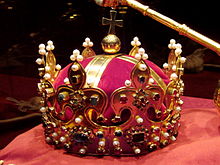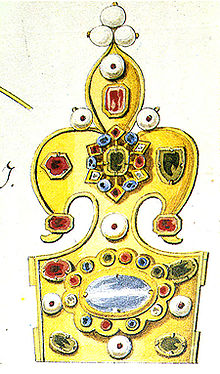- Crown of Bolesław I the Brave
-
The Crown of Bolesław I the Brave (in Polish: Korona Chrobrego, also known in Latin as the Corona Privilegiata) was the coronation crown of the Polish monarchs.
Contents
History
The origins of the Polish crown are shrouded in mystery. According to legend the story dates back to the Congress of Gniezno in the year 1000, when Bolesław I the Brave, Duke of Poland, received from Otto III, Holy Roman Emperor a replica of the Holy Lance and a crown, both symbolising royal power. The crown was lost in the course of history, maybe taken away to Germany in 1036 by Queen Richeza. It was only in 1320 that a new set of regalia was prepared for the coronation of King Ladislaus the Short and survived until the 18th century.[1]
The crown along with the crown jewels was kept in the cathedral treasury at Wawel Castle. During the reign of the Jagiellon dynasty it was moved to the Crown Treasury of the castle. The crown was often removed from the Wawel, for example in 1370, when Louis I of Hungary took it away, returning in 1412. In the 17th century the crown was moved to Warsaw for the coronations of the queens. During the Swedish Deluge in the years 1655-1661, the crown was hidden away in Spiš in today's Slovakia. In the 18th century it moved around again, particularly to Silesia and Moravia. Although returned to Wawel Castle in 1730, only three years later it was taken again to Warsaw. In 1734 the crown was left at the Pauline Jasna Góra Monastery, where it remained until 1736. On the occasion of the coronation of Stanisław August Poniatowski on November 25, 1764 in St. John's Cathedral, Warsaw, the crown was transported from Krakow to Warsaw for the last time. It returned to Wawel Castle where it remained until its theft.[1]
The seizure of Krakow by the Prussian army in 1794 had dramatic consequences. The crown treasury was plundered and the royal insignia robbed and later melted down on the order of the Prussian king. Out of the gold, a number of coins were minted. Of all the Polish crown regalia, only the sword Szczerbiec would survive.[2]
Based on historical drawings, paintings, descriptions and using a number of Prussian coins believed to have been minted from the gold of the crown in 1811, a team led by Adam Orzechowski of Nowy Sącz produced a recreation in 2001-2003 .[3]
The crown was 10 inches high, with 7.8 in. external diameter and 7.3 in. internal diameter, weighing around 2.82 pounds . The replica crown is made out of 21 oz . gold, 21 oz . silver, 11 synthetic rubies, 88 emeralds, sapphires and garnets 0.5 to 1 in. in diameter, 184 gems 0.15 to 0.2 in. in diameter, 80 pearls, and 5 square feet (0.46 m2) of royal purple silk velvet, which is probably very similar to the dimensions of the original crown.[4]
References
- ^ a b "Zarys Historii Regaliów Królestwa Polskiego" (in Polish). Historia Repliki Polskich Insygniów Koronacyjnych. http://www.replikiregaliowpl.com/zarys.html. Retrieved 2010-08-04.
- ^ "Kradzież i Zniszczenie..." (in Polish). Historia Repliki Polskich Insygniów Koronacyjnych. http://www.replikiregaliowpl.com/kradziez.html. Retrieved 2010-08-04.
- ^ "Idea Odtworzenia Regaliów" (in Polish). Historia Repliki Polskich Insygniów Koronacyjnych. http://www.replikiregaliowpl.com/idea.html. Retrieved 2010-08-04.
- ^ "Jak Powstawały Repliki" (in Polish). Historia Repliki Polskich Insygniów Koronacyjnych. http://www.replikiregaliowpl.com/jak.html. Retrieved 2010-08-04.
Further reading
- Jürgen Abeler. Kronen. Herrschaftszeichen der Welt. Düsseldorf, 1980 (German)
- Karol Estreicher. Zniszczenie polskich insygniów koronnych. Kraków, Przegląd Współczesny. 1935 (Polish)
- Karol Estreicher. The Mystery of the Polish Crown Jewels. London, Alliance Press Limited. 1945?
- Jerzy Lileyko. Regalia Polskie. Warsaw 1987. ISBN 83-03-02021-8 (Polish)
- Janusz Miniewicz. Tajemnica polskich koron. Czy jest szansa ich odnalezienia? Nowy Sącz 2006. ISBN 83-924034-2-8 (Polish)
- Michał Rożek. Tajemnice insygniów królewskich. Kraków, 1985. (Polish)
- Michał Rożek. Polskie koronacje i korony. Kraków 1987. ISBN 83-03-01914-7 (Polish)
- Alfred Znamierowski. Insygnia, symbole i herby polskie. Warsaw, 2003. (Polish)
External links
 Media related to Crown of Bolesław I the Brave at Wikimedia Commons
Media related to Crown of Bolesław I the Brave at Wikimedia CommonsCrowns English, Scottish, Welsh
and British crowns
(by chronology)Palatine Crown · Crown of Scotland · St Edward's Crown · Crown of Mary of Modena · State Crown of George I · Coronet of Frederick, Prince of Wales · Coronation Crown of George IV · Crown of Queen Adelaide · Imperial State Crown · Small diamond crown of Queen Victoria · Crown of Queen Alexandra · Coronet of George, Prince of Wales · Crown of Queen Mary · Imperial Crown of India · Crown of Queen Elizabeth · Coronet of Charles, Prince of WalesHoly Roman Empire,
German, Austrian,
Bohemian
and Italian crownsIron Crown of Lombardy · Reliquary Crown of Otto II · Crown of Otto III · Reliquary Crown of Empress Cunigunde · Reliquary Crown of Henry II · Imperial Crown of the Holy Roman Empire · Salian Funeral Crowns of Spires · Kamelaukion of Frederick II or Constance of Sicily · Reliquary Crown of Charlemagne (14th century) · Crown of St. Wenceslas (Bohemian lands) · Crown of Blanche of Valois (Bohemian lands) · Electoral Hat of Saxony · Ducal hat of Styria · Archducal hat (Archducal hat of Tyrol · Archducal hat of Joseph II) Crown of the Grand Duchy of Tuscany · Imperial Crown of Austria · Crown of Frederick I (Prussia) · Crown of Charlotte (Prussia) · Imperial Crowns of Charles VII · Napoleonic Crown of Italy · Royal Crown of Bavaria · Royal Crown of Württemberg · Royal Crown of Hanover · Grand Ducal Crown of Baden · Crown of Empress Elizabeth (Austria) Crown of Wilhelm I (Prussia) · German State Crown · Crown of Wilhelm II (Prussia)Polish crowns Crown of Bolesław I the Brave · Swedish Crown · Muscovy Crown · Hungarian Crown · Homagial Crown · Funeral Crown · Queens Crown · Crown of Augustus II · Crown of Augustus III · Crown of Maria Josepha · Płock DiademRussian crowns "Cap of Monomakh" · Crown of Kazan Tzardom · Crown of Tsar Michael Fyodorovich · Cap of Monomakh of the second set · Diamond crown of Tsar Peter I · Diamond crown of Tsar Ivan V · Altabas crown of the third set · Crown of Empress Catherine I · Crown of Empress Anna Ivanovna · Great Imperial Crown · Maltese Crown · Small Imperial CrownFrench crowns Crown of Charlemagne · Sainte Couronne · Crown of Louis XV · Crown of Napoleon I · Crown of Charles X · Crown of Napoleon III · Crown of Empress EugenieOther European crowns Crown of Crown Prince Carl (Norway) · Crown of Christian IV (Denmark) · Crown of Christian V (Denmark) · Crown of Zvonimir (Croatia) · Crown of Eric XIV (Sweden) · Crown of William I (Netherlands) · Crown of William II (Netherlands) · Crown of Norway · Crown of Portugal · Crown of the Queen of Norway · Crown of Elisabeta (Romania) · Crown of Maria (Romania) · Holy Crown of Hungary (Hungary) · Crown of Peter I (Serbia) · Crown of Martin of Aragon · Royal Crown of Spain · Crown of Greece · Papal Tiara · Crown of Rus (Ukraine) · Steel Crown of RomaniaNon-European crowns Crown of Faustin I (Haiti) · Empress Crown (Iran/Persia) · Great Crown of Victory (Siam/Thailand) · Kiani Crown (Iran/Persia) · Imperial Crown of Brazil · Imperial Crown of Mexico · Crown of Sri Vikrama Rajasinha of Sri Lanka · Pahlavi Crown (Iran/Persia) · Crown of Silla (Korea) · Crown of Hawaii · Crown of Tahiti · Crown of Madagascar · Crown of Ranavalona III · Silver crown of Emperor Tewodros (Ethiopia)See also Coronation · Crown Jewels · Heir Apparent · Heir Presumptive · King · Monarchy · Queen · Regalia · Royal FamilyNational symbols of Poland Constitutional Military Historical Patron saints Names and codes Unofficial CategoryCategories:- Crowns
- Crown jewels of Poland
Wikimedia Foundation. 2010.




